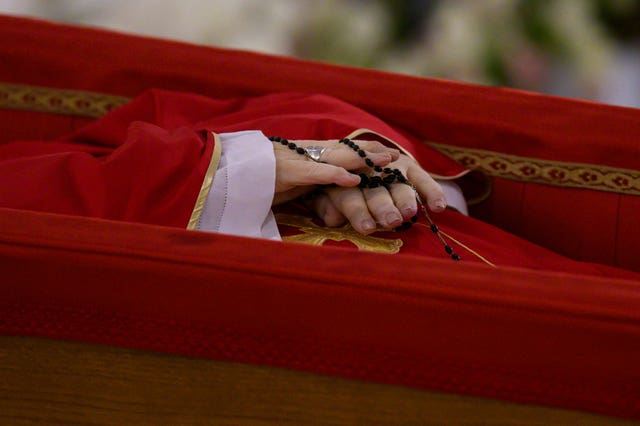Pope Francis death: What happens next?
The late pontiff’s body will lie in state for public viewing, followed by a funeral and mourning period.

A huge gathering of the Catholic faithful will come together to grieve the loss of Pope Francis in the coming days, followed by the secretive and potentially lengthy process of cardinals choosing a new pontiff.
Here, the PA news agency takes a look at what happens next.
– Lying in state

The first images of the late Pope’s body were published on Tuesday morning, a day after his death.
They showed him lying in a wooden casket, dressed in red religious garments with rosary prayer beads draped across his hands.
His body was lying in the private chapel of the Casa Santa Marta residence where he had chosen to live, away from the grander papal palace in the Vatican.
On Wednesday morning his body will be brought to St Peter’s Basilica, in a procession through Santa Marta Square and the Square of the Roman Protomartyrs.
On arrival into St Peter’s Square, it will enter the Basilica through the central door.
From there, Francis’s body will lie in public view ahead of the funeral, so people can pay their respects to the late pontiff.
Large queues are expected to form, with the body likely to be on display 24 hours a day, according to expert Joe Ronan who works with the Catholic Voices media charity.
He recalled hundreds of thousands having queued to see the previous pope, Benedict, and said “numbers are likely to be very strong” to see Francis.
His simple casket – as opposed to the three wooden coffins used for previous popes – will, according to his wishes, not be placed on an elevated platform.
– Funeral

Following a meeting of cardinals on Tuesday, it was confirmed Francis’s funeral will take place at 10am local time on Saturday, in St Peter’s Square.
Huge crowds are expected at the outdoor mass which will be presided over by Cardinal Giovanni Battista Re, who is the dean of the College of Cardinals.
Prime Minister Sir Keir Starmer is among the world leaders confirmed to be attending.
US President Donald Trump has also already said he will be there with his wife Melania.
In his will, Francis requested that he is buried in a simple underground tomb at St Mary Major Basilica.
While a requiem mass is usually a standard length of around an hour, Mr Ronan said that “with the practicalities of working with that number of people” including those wishing to receive Holy Communion, it is likely to run closer to 90 minutes.
– Mourning

Following the funeral, the “novendiali” takes place – nine days of official mourning.
The funeral marks the first day of this period, with the final day on Sunday May 4.
The Church is currently in “sede vacante”, or “the vacant See”. This happened at the moment of the Pope’s death.
– Conclave
The secret meeting of cardinals, known as the conclave, usually beings between 15 and 20 days after a pope’s death.
Although Mr Ronan said if cardinals agree, then it could begin earlier.
Following the period of mourning, May 5 seems a likely date on which it might start, he added.
Only cardinals who were aged 80 or under on the day of the Pope’s death have a vote.

While there must be a minimum of 120 cardinals – senior members of the Catholic Church – in the conclave, Mr Ronan said there are currently around 135 cardinals of voting age.
The conclave convenes in the Sistine Chapel, where there can be up to four votes each day.
There is no set time for the conclave to elect a new pope, and if it carries on for a long time it is possible for the cardinals to take a break, and have a non-voting day, Mr Ronan said.
He said: “It could conceivably go on for quite some time.”
A two thirds majority is required for a new pope to be elected.
Each time there is a vote, the ballots are then burned with black smoke from a chimney of the Sistine Chapel indicating no-one has been elected and white confirming a new pontiff.
Mr Ronan said there is expected to be a double confirmation, to avoid confusion: “As well as the white smoke I think they will also ring the bells of St Peter’s as a double check.
“These days they go to great pains to make sure that the colour of the smoke is very clear, sometimes (in the past) you have had a sort of grey colour.”
Once a new pope accepts his election, it is usual that he would appear “relatively rapidly” on the front balcony of St Peter’s Basilica which overlooks the square.
An announcement in Latin of “Habemus Papam” – meaning “we have a pope” is made alongside the new pontiff’s appearance.





